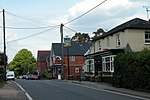Bordon and Longmoor Military Camps
Army installations of CanadaBarracks in EnglandBuildings and structures in HampshireInstallations of the British ArmyMilitary in Hampshire

Bordon and Longmoor Military Camps are British Army training camps close to the A3 and A325 roads in and around the settlements of Bordon, Longmoor, Liss and Liphook in Hampshire, England. The main street of the Longmoor part of the camp is built on an ancient Roman road, the Chichester to Silchester Way, while the village of Greatham lies to the west. The combined camp and training area coveres 1,783 hectares (4,410 acres) of wooded areas, heath, wetlands and hard standings. Longmoor camp and the training areas are still active, and maintained by the Defence Infrastructure Organisation.
Excerpt from the Wikipedia article Bordon and Longmoor Military Camps (License: CC BY-SA 3.0, Authors, Images).Bordon and Longmoor Military Camps
Methuen Road, East Hampshire Whitehill
Geographical coordinates (GPS) Address Nearby Places Show on map
Geographical coordinates (GPS)
| Latitude | Longitude |
|---|---|
| N 51.073055555556 ° | E -0.86888888888889 ° |
Address
Methuen Road
Methuen Road
GU33 6EL East Hampshire, Whitehill
England, United Kingdom
Open on Google Maps



